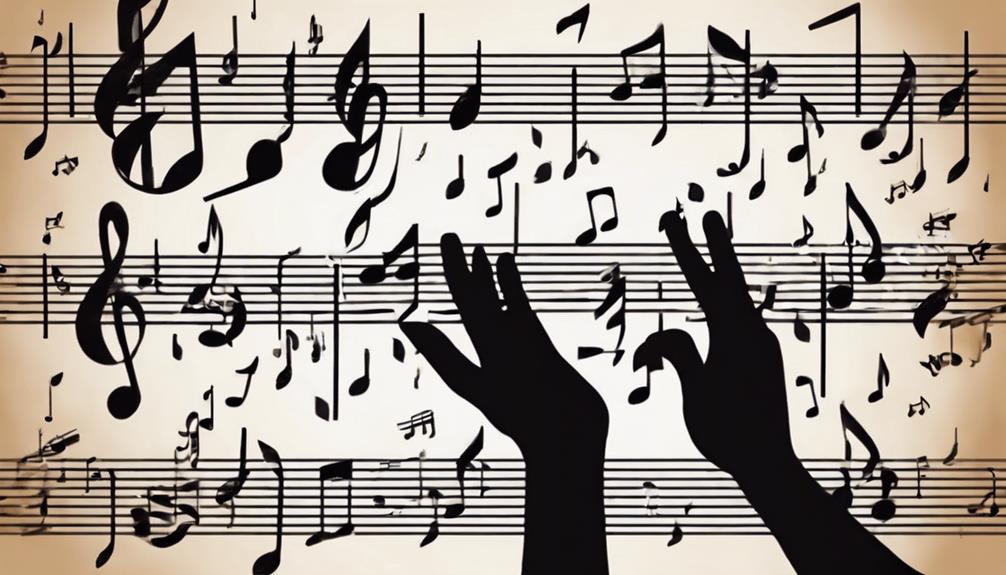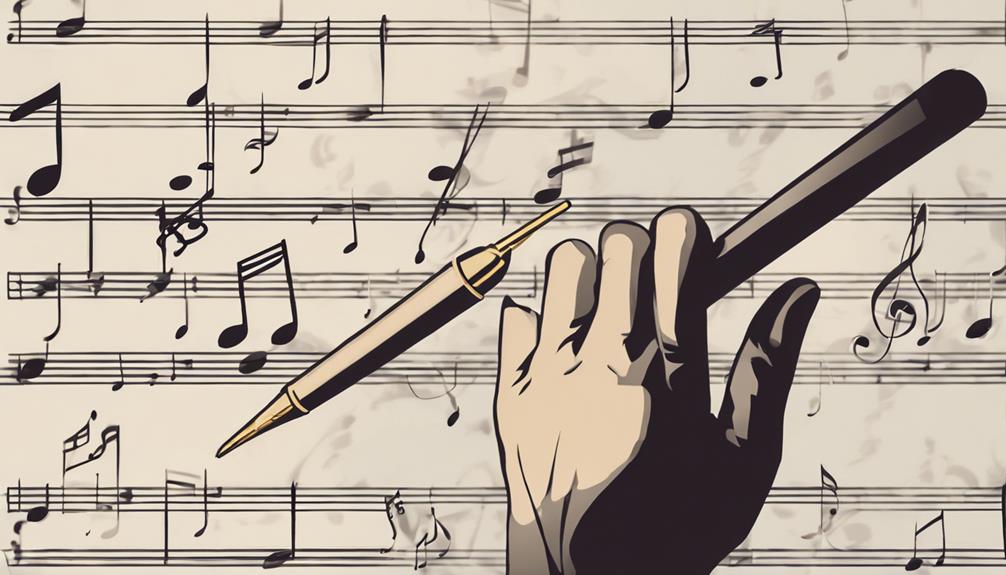No products in the cart.
In music, the upper number in a time signature tells you the beats per measure, laying the foundation for the song’s rhythmic structure. It’s a core piece of the puzzle in music theory, guiding how you count and perceive the pulse of the music. Whether it’s a simple meter with duple, triple, or quadruple beats, or a compound meter offering a triple meter feel through beat groupings, this number is key. It dictates the rhythmic patterns you’ll execute and shifts to signify changes in rhythmic structure. Understanding this will not only enhance your rhythmic execution but also shape your musical phrasing, bringing you closer to mastering the nuances of emotional and rhythmic expression in music.
Contents
hide
Key Takeaways
- The upper number in a time signature indicates the number of beats in each measure.
- It sets the rhythmic foundation by instructing how to count beats within a measure.
- This number directly impacts the execution of rhythmic patterns in music.
- A change in the upper number signifies a shift in the rhythmic structure of the piece.
- Understanding the upper number is essential for interpreting the music’s pulse and feel.
Deciphering Time Signatures
Understanding the upper number in a time signature is essential as it directly dictates the number of beats per measure, serving as the foundation for a composition’s rhythmic structure. This core aspect of music theory isn’t just about deciphering; it’s about deeply engaging in rhythmic analysis to reveal the intricacies of musical expression. The upper number isn’t a mere indicator; it’s a guide that shapes your pulse perception, allowing you to internalize the tempo and flow of the piece you’re either listening to or performing.
When you’re tackling a piece of music, your initial step involves interpreting this number to comprehend the rhythmic pattern you’re about to navigate. Whether it’s a duple, triple, or quadruple meter, indicated by common upper numbers like 2, 3, or 4, each brings its unique rhythmic flavor and challenges. This isn’t just academic; it’s practical. Your ability to grasp these differences enhances your musical interpretation, enabling you to emphasize certain beats over others, contributing to the piece’s overall mood and dynamics.
In essence, mastering pulse perception through diligent rhythmic analysis of the time signature’s upper number equips you with the tools to deliver a more nuanced, expressive performance. This foundational knowledge is indispensable, forming the bedrock upon which musical proficiency is built.
Understanding Beats Per Measure
Delving into the intricacies of musical time signatures, you’ll find that the upper number plays a pivotal role in defining the precise number of beats within each measure, thereby establishing the rhythmic foundation essential for consistent performance. This number, whether it’s 2, 3, or 4, fundamentally instructs you on the counting beats necessary for executing rhythmic patterns accurately. When you’re interpreting music, this understanding allows you to organize and execute these patterns with clarity and precision.
For instance, a piece marked with an upper number of 2 denotes a duple meter, suggesting that each measure contains two beats. This is fundamental in maintaining a consistent rhythm, as it guides you in counting beats in a structured manner. Similarly, triple and quadruple meters, indicated by 3 and 4 respectively, introduce different rhythmic feels but adhere to the same principle of counting beats within each measure. This aspect of rhythm notation is vital for musicians to synchronize their performances, ensuring each note is played in its rightful temporal space.
Moreover, when the upper number changes within a piece, it signals a shift in the rhythmic structure, challenging you to adapt your counting and execution of rhythmic patterns accordingly. This adaptability is key in traversing the dynamic landscapes of musical compositions, making a deep understanding of beats per measure indispensable.
Simple Vs. Compound Time
Exploring the domain of musical time signatures, you’ll encounter an important distinction between simple and compound times that shapes the rhythmic texture of compositions. In simple time signatures, the upper number reveals how many beats are in a measure, laying the groundwork for the rhythmic structure. For instance, 2/4 time indicates 2 beats per measure, while 3/4 time suggests 3. These are classified under duple, triple, or quadruple meters, directly influencing how notes are grouped and accented, thereby crafting the unique time signature nuances of a piece.
On the flip side, compound time signatures, with upper numbers like 6, 9, or 12, diverge by emphasizing groupings of three beats per measure. This subtle yet profound difference doesn’t just alter the count; it transforms the entire feel of the music. Compound times, as a result, offer a triple meter feel regardless of the actual beat count, adding a layer of complexity to the interpretation of rhythms and necessitating a nuanced understanding of meter to accurately execute the intended musical expression. Such knowledge is important for musicians aiming to navigate the intricate world of rhythmic structures and play pieces as they were conceived, highlighting the significance of grasping these fundamental concepts.
Reading and Interpretation
To accurately interpret and perform a musical piece, it’s essential to explore the nuances of its time signature, focusing on how the upper number’s indication of beats per measure shapes rhythmic execution and musical phrasing. This number, whether it’s 2, 3, or 4, not only dictates the meter—duple, triple, or quadruple—it greatly influences the music’s pulse and feel. Grasping this concept is fundamental for any musician aiming to convey the composition’s intended emotional and rhythmic expression.
Understanding the upper number allows for a detailed rhythmic analysis, laying the groundwork for the application of precise performance techniques. It’s not just about counting beats; it’s about recognizing the rhythmic structure that guides the grouping of notes, the placement of accents, and the overall phrasing. This comprehension fosters musical precision, enabling you to shape the dynamics and articulation in a way that brings coherence and depth to the performance.
Analyzing the upper number in the time signature is hence critical. It helps establish a rhythmic foundation that’s essential for maintaining coherence throughout the piece, ensuring that each note and rest is played with intention and accuracy.
Common Time Signature Examples
Several common time signatures, including 4/4, serve as the backbone for myriad music genres, offering a balanced and predictable rhythmic structure. You’ll find that understanding these signatures is essential for maintaining consistent timing and tempo, which is fundamental in music composition and performance.
Here are examples of common time signatures and their impact on rhythmic patterns:
- 4/4 Time Signature: Often referred to as ‘common time,’ this signature provides a stable and regular rhythm, making it the most prevalent in Western music. Each measure contains four beats, with each beat receiving a quarter note’s duration.
- 3/4 Time Signature: This signature, known for its waltz rhythm, contains three beats per measure. It’s characterized by a strong first beat followed by two weaker beats, creating a distinctive, flowing pattern.
- 2/4 Time Signature: With two beats per measure, this time signature is common in marches and polkas. The rhythm feels brisk and lively, as it emphasizes a strong downbeat followed by a lighter upbeat.
- 6/8 Time Signature: Though not a simple meter like the others, 6/8 offers a compound rhythm where two main beats are divided into three, giving it a lilting, flowing feel often found in folk and jazz genres.
Frequently Asked Questions
What Does the Upper Number Tell in a Musical Time Signature?
The upper number in a musical time signature tells you about beat grouping and rhythmic complexity. It indicates how many beats are in each measure, shaping the piece’s rhythm and guiding your performance.
What Does the Upper Number in the Time Signature Mean?
The upper number in the time signature means you’re looking at the beat grouping per measure, essential for understanding the rhythmic complexity. It’s how you’ll decode the music’s pulse and tackle its technical aspects accurately.
What Does the Top Number in a Time Signature Determine?
The top number in a time signature determines beat grouping and the rhythmic complexity within a measure, guiding you on how to accurately interpret and perform the music’s intended rhythmic pattern and emphasis.
What Does the Top Number Represent in Written Musical Meters?
The top number in written musical meters represents beat division, important for understanding rhythmic complexity. It dictates how beats are grouped in each measure, guiding you in interpreting the piece’s overall rhythmic structure accurately.
Conclusion
To sum up, you’ve now discovered the secret to understanding the upper number in a musical time signature. It represents the beats per measure, a crucial element in comprehending a piece’s rhythmic structure.
Whether you’re dealing with simple or compound time, this number directs your reading and interpretation, aiding you in navigating through the music with accuracy.
By studying common time signature examples, you’ve refined your analytical skills, enhancing a more nuanced appreciation and execution of musical compositions.




